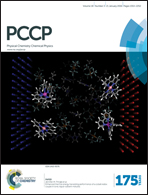Phase transition kinetics of LiNi0.5Mn1.5O4 analyzed by temperature-controlled operando X-ray absorption spectroscopy†
Abstract
LiNi0.5Mn1.5O4 (LNMO) is a promising positive electrode material for lithium ion batteries because it shows a high potential of 4.7 V vs. Li/Li+. Its charge–discharge reaction includes two consecutive phase transitions between LiNi0.5Mn1.5O4 (Li1) ↔ Li0.5Ni0.5Mn1.5O4 (Li0.5) and Li0.5 ↔ Ni0.5Mn1.5O4 (Li0) and the complex transition kinetics that governs the rate capability of LNMO can hardly be analyzed by simple electrochemical techniques. Herein, we apply temperature-controlled operando X-ray absorption spectroscopy to directly capture the reacting phases from −20 °C to 40 °C under potential step (chronoamperometric) conditions and evaluate the phase transition kinetics using the apparent first-order rate constants at various temperatures. The constant for the Li1 ↔ Li0.5 transition (process 1) is larger than that for the Li0.5 ↔ Li0 transition (process 2) at all the measured temperatures, and the corresponding activation energies are 29 and 46 kJ mol−1 for processes 1 and 2, respectively. The results obtained are discussed to elucidate the limiting factor in this system as well as in other electrode systems.


 Please wait while we load your content...
Please wait while we load your content...